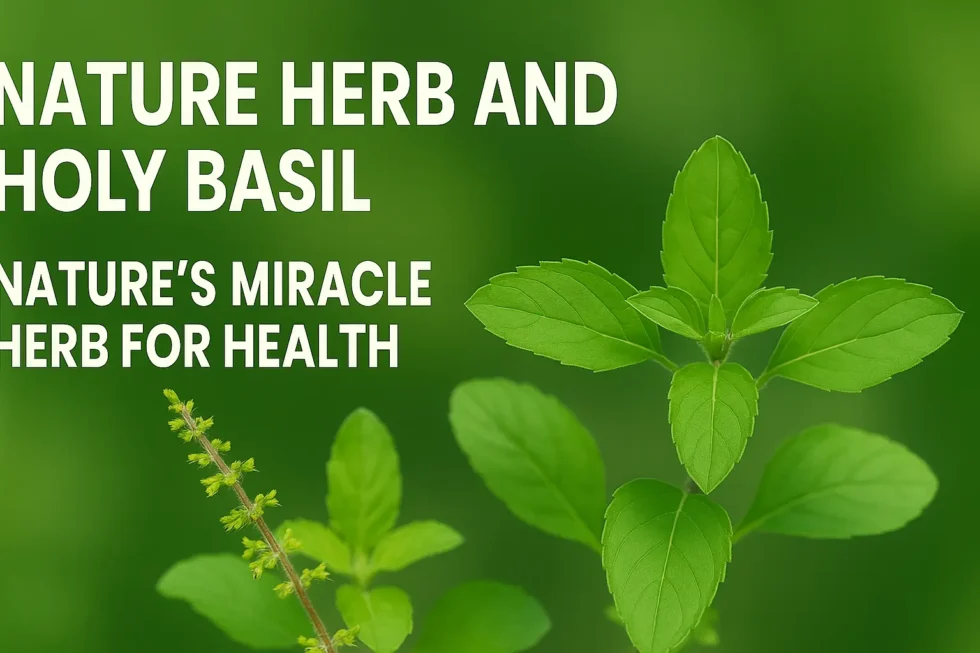
Holy Basil, or Ocimum sanctum and Tulsi as it’s also called, is truly special in the world of plants, spirituality, and natural healing
Exploring the Sacred Varieties of Holy Basil: Nature’s Diverse Healer
Coming from the Indian subcontinent and held in high regard for over 3,000 years, it’s more than just a plant—it stands for purity, good health, and divine protection. Its amazing mix of health perks, spiritual importance, and deep cultural roots makes it a plant treasure unlike any other.
Types of Holy Basil-
Rama Tulsi
Krishna Tulsi
Vana Tulsi
Kapoor Tulsi
Amrita Tulsi
1. Rama Tulsi (Green Leaf Tulsi)
Scientific Name: Ocimum sanctum
Color: Vibrant green leaves
Taste: Gentle, sweet, and calming
Aroma: A subtle hint of clove-like fragrance
Uses: Frequently found in Ayurvedic remedies, herbal teas, and everyday rituals
Health Benefits: Helpful for coughs, colds, respiratory issues, and reducing stress
Special Feature: The most common type in Indian homes, often what people think of when they hear “Tulsi” and Nature Herb And Holy Basil.
2. Krishna Tulsi (Shyama Tulsi or Purple Leaf Tulsi)
Scientific Name: Ocimum tenuiflorum
Color: Purple or deep green leaves and stems
Taste: More intense, spicy, and peppery
Aroma: A strong, clove-like scent
Uses: Often chosen in traditional medicine for treating infections and serious illnesses
Health Benefits: Celebrated for its strong antioxidant and anti-inflammatory effects
Special Feature: Considered more powerful in Ayurveda, especially for skin conditions, throat infections, and high fevers.
3. Vana Tulsi (Wild Forest Tulsi)
Scientific Name: Ocimum gratissimum
Color: Light green leaves; a taller plant
Taste: Lemon-like with a slight bitterness
Aroma: A refreshing, citrusy scent
Uses: Commonly used in herbal teas and immune-boosting blends
Health Benefits: Great for enhancing immunity, energy, and digestion
Special Feature: Native to Africa and parts of India, it grows wild in forests and isn’t as commonly grown in home gardens.
4. Amrita Tulsi
This is a special blend of plants, primarily utilized in Ayurvedic practices for helping the body get rid of toxins.
5. Kapoor Tulsi
This variety is quite popular in the U.S. and Europe, celebrated for its sweet scent and its ability to keep pests away. You’ll often find it planted in gardens or included in herbal tea mixes.
How it use in cooking-
It’s is a fantastic ingredient to use in the kitchen, bringing a unique flavor and some great health perks to all sorts of dishes. While you’ll usually find it featured in Ayurvedic medicine and herbal remedies, certain types of Tulsi—especially Rama Tulsi and Vana Tulsi—really shine as culinary herbs in some specific cuisines and Nature Herb And Holy Basil.
| Dish Type | How to Use Holy Basil | Benefit |
|---|---|---|
| Tea | Boil fresh/dry leaves | Immunity, stress relief |
| Soups/Broths | Add while simmering | Aroma, cold & flu relief |
| Rice/Lentils | Use during tempering | Digestive boost, flavor enhancer |
| Chutneys/Salads | Add raw leaves | Detox, fresh taste |
| Curries/Stir-fries | Add during sautéing | Unique spice layer |
| Drinks | Infuse in lemon water/smoothie | Refreshing, anti-inflammatory |
How it is Beneficial in Beauty Treatment-
Tulsi, is a real gem in natural beauty! It’s packed with amazing benefits – think purifying, healing, and anti-aging. For centuries, it’s been a staple in Ayurvedic skincare, and it really shines when it comes to tackling acne, fading pigmentation, boosting hair care, and just generally keeping your skin looking healthy and Nature Herb And Holy Basil.
| Beauty Use | How to Use | Key Benefit |
|---|---|---|
| Acne Treatment | Face pack with Tulsi + rose water | Reduces pimples and inflammation |
| Skin Brightening | Face mask with yogurt/sandalwood | Fades blemishes, evens skin tone |
| Steam Facial | Boil leaves for facial steam | Detoxifies, clears pores |
| Toner | Tulsi water as mist or toner | Refreshes skin, tightens pores |
| Hair Care | Tulsi with oil or amla powder | Fights dandruff, promotes growth |
| Anti-Aging | Paste with honey and milk | Firms skin, reduces wrinkles |
| Instant Glow | Rub Tulsi ice cubes | Soothes skin, tightens pores |
How it also use in Medical field-
Tulsi, is one of the most powerful herbs in traditional and modern medicine. Revered in Ayurveda, Unani, and even integrated into modern pharmacology, Tulsi offers a wide range of therapeutic benefits due to its antioxidant, anti-inflammatory, adaptogenic, antimicrobial, and immunomodulatory properties.
| Medical Use | Form of Tulsi | Primary Benefit |
|---|---|---|
| Stress & Anxiety | Tea, capsules | Calms mind, balances hormones |
| Immunity | Decoction, drops | Fights infections, boosts defense system |
| Respiratory Issues | Syrup, steam, tea | Clears lungs, treats cough & asthma |
| Blood Sugar Control | Juice, powder, tablets | Regulates glucose and insulin sensitivity |
| Heart Health | Capsules, leaf extract | Lowers cholesterol, protects heart |
| Cancer Research | Extracts, decoctions | Antioxidant, supports cell repair |
| Inflammation/Pain | Oil, paste, supplements | Reduces swelling and chronic pain |






Plumeria Tree Benefits: Nature’s Scented Jewel of the Tropics - Panda Pandi